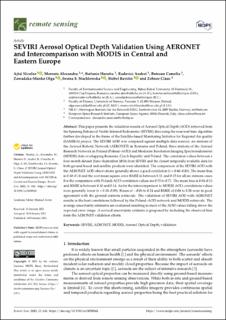| dc.contributor.author | Ajtai, Nicolae | |
| dc.contributor.author | Mereuta, Alexandru | |
| dc.contributor.author | Stefanie, Horatiu | |
| dc.contributor.author | Radovici, Andrei | |
| dc.contributor.author | Botezan, Camelia | |
| dc.contributor.author | Zawadzka-Manko, Olga | |
| dc.contributor.author | Stachlewska, Iwona S. | |
| dc.contributor.author | Stebel, Kerstin | |
| dc.contributor.author | Zehner, Claus | |
| dc.date.accessioned | 2021-03-24T13:32:42Z | |
| dc.date.available | 2021-03-24T13:32:42Z | |
| dc.date.created | 2021-03-17T10:29:06Z | |
| dc.date.issued | 2021 | |
| dc.identifier.citation | Remote Sensing. 2020, 13, 844. | en_US |
| dc.identifier.issn | 2072-4292 | |
| dc.identifier.uri | https://hdl.handle.net/11250/2735317 | |
| dc.description.abstract | This paper presents the validation results of Aerosol Optical Depth (AOD) retrieved from the Spinning Enhanced Visible Infrared Radiometer (SEVIRI) data using the near-real-time algorithm further developed in the frame of the Satellite-based Monitoring Initiative for Regional Air quality (SAMIRA) project. The SEVIRI AOD was compared against multiple data sources: six stations of the Aerosol Robotic Network (AERONET) in Romania and Poland, three stations of the Aerosol Research Network in Poland (Poland–AOD) and Moderate Resolution Imaging Spectroradiometer (MODIS) data overlapping Romania, Czech Republic and Poland. The correlation values between a four-month dataset (June–September 2014) from SEVIRI and the closest temporally available data for both ground-based and satellite products were identified. The comparison of the SEVIRI AOD with the AERONET AOD observations generally shows a good correlation (r = 0.48–0.83). The mean bias is 0.10–0.14 and the root mean square error RMSE is between 0.11 and 0.15 for all six stations cases. For the comparison with Poland–AOD correlation values are 0.55 to 0.71. The mean bias is 0.04–0.13 and RMSE is between 0.10 and 0.14. As for the intercomparison to MODIS AOD, correlations values were generally lower (r = 0.33–0.39). Biases of −0.06 to 0.24 and RMSE of 0.04 to 0.28 were in good agreement with the ground–stations retrievals. The validation of SEVIRI AOD with AERONET results in the best correlations followed by the Poland–AOD network and MODIS retrievals. The average uncertainty estimates are evaluated resulting in most of the AOD values falling above the expected error range. A revised uncertainty estimate is proposed by including the observed bias form the AERONET validation efforts. | en_US |
| dc.language.iso | eng | en_US |
| dc.rights | Navngivelse 4.0 Internasjonal | * |
| dc.rights.uri | http://creativecommons.org/licenses/by/4.0/deed.no | * |
| dc.title | SEVIRI Aerosol Optical Depth Validation Using AERONET and Intercomparison with MODIS in Central and Eastern Europe | en_US |
| dc.type | Peer reviewed | en_US |
| dc.type | Journal article | en_US |
| dc.description.version | publishedVersion | en_US |
| dc.rights.holder | © 2021 by the authors. Licensee MDPI, Basel, Switzerland. | en_US |
| dc.source.volume | 13 | en_US |
| dc.source.journal | Remote Sensing | en_US |
| dc.identifier.doi | 10.3390/rs13050844 | |
| dc.identifier.cristin | 1898572 | |
| dc.relation.project | NILU: 116074 | en_US |
| dc.relation.project | ESA-ESRIN: 4000117393/16/I-NB | en_US |
| dc.source.articlenumber | 844 | en_US |
| cristin.ispublished | true | |
| cristin.fulltext | original | |
| cristin.qualitycode | 1 | |

